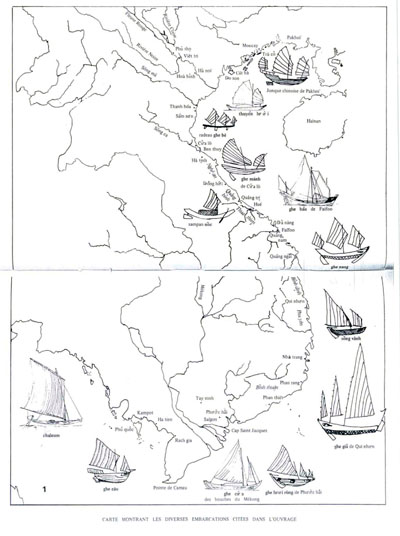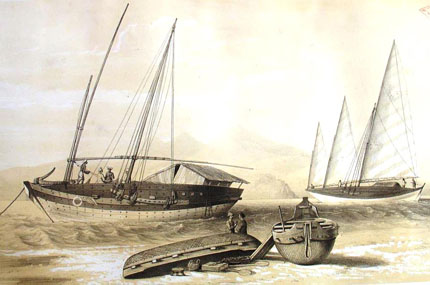
Map showing the diversity and repartition of boat types in Vietnam (Aubaile-Sallenave 1987:1) View larger version here.
The Boat Building Traditions Research project
The boat building traditions research project is conducted by Charlotte Minh Ha Pham who is a PhD candidate in the Asia Research Center at Murdoch University. Her research aims to reconstruct the maritime landscape of central Vietnam (16th-19th century) through boat ethnography and archival research.
The Vietnam coastline spreads over 3 444 km, along which a great variety of sailing vessels can still be observed. Through the historical records and documentation that exists on boats of Vietnam, Charlotte has catalogued over 50 types, categorized along 6 hull types, that vary by length, breadth, construction materials, fastenings techniques, and propulsion devices.
In present-day Vietnam, 82 different ethnic groups and 53 different languages have been documented. This rich cultural diversity is the product of a longstanding exchange and migration since the dispersal of the Austronesian ethno-linguistic group during the Neolithic. The country’s strategic location made it a cultural crossroads, which was significant in the history and trade of Southeast Asia and beyond. Across time and space, cultural diffusion continuously shaped Vietnam and its boat technology, with influences pervading not only from the Chinese in the north, the Cham in the centre, the Funanese in the south-west, and the Malay Peninsula to the south; but also from beyond the Indian Ocean, with Arab and the European presence since the end of the first millennium AD.

Boats anchored in the Bay of Tourane (Pâris, François-Edmond. 1841. Essai sur la construction navale des peuples extra-européens, ou Collection des navires et pirogues construits par les habitants de l'Asie, de la Malaisie, du Grand Océan et de l'Amérique, dessinés et mesurés pendant les voyages autour du monde de L'Astrolabe, La Favorite et L'Artémise. Paris: Arthus Bertrand, plate 45)
These various influences are clearly reflected in the contemporary boat record. John Barrow had also noticed this multiple set of influences in 1793: ”the vessels that are employed in the coasting trade, the fishing craft, and those which collect the trepang and swallows' nests …, are of various descriptions: many of them, like the Chinese Sampans, covered with sheds of matting, under which a whole family constantly resides; and others, resembling the common praos of Malays, both as to their hulls and rigging.”
How to address this diversity and these influences? How to track the technological changes and transformation, and the evolution across time? How to give boats meaning and highlight their role in a historical context?
The study of boat building traditions of Vietnam forms the heart of this PhD research. It is conducted under the auspices of the Major Collaborative Research Initiative: «The Indian Ocean World: The Making of the First Global Economy in the Context of Human- Environment Interaction”, as part of Professor Jim Warren’s team. This research receives additional supervision from Professor Jeremy Green from the Western Australia Museum and and Dr. Wendy Van Duivenvoorde from Flinders University.
http://www.indianoceanworldcentre.com/Team_2
http://wwwarc.murdoch.edu.au/researchers/staff/cpham.html
Next
